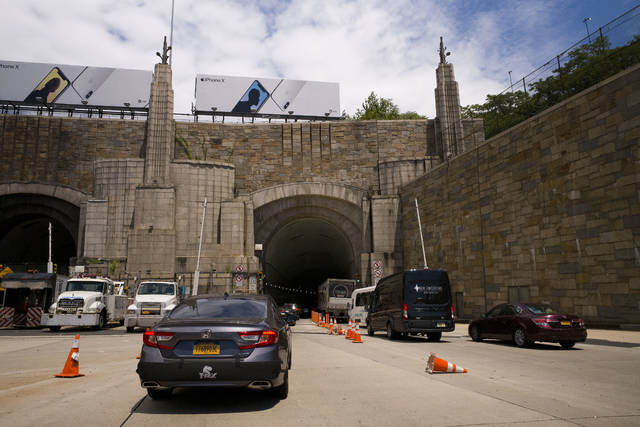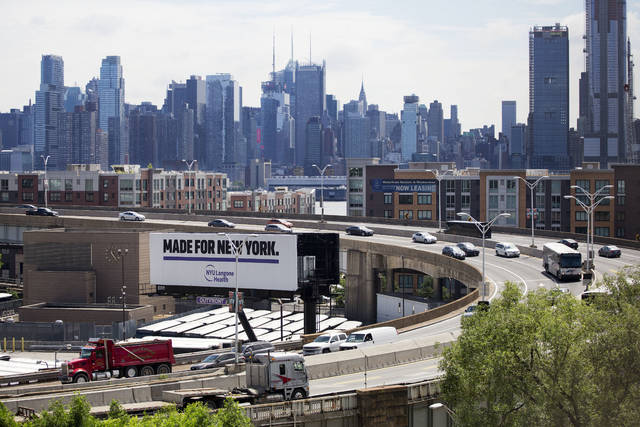NORTH BERGEN, N.J. — It is the bane of tourists and truckers, theatergoers and weekday 9-to-5ers: the congested, pothole-strewn roadway that bisects the teeming towns overlooking the Hudson River before descending into the Lincoln Tunnel to New York City.
In a region known for its soul-crushing gridlock and delay-prone rail system, the 80-year-old Route 495 viaduct connecting the New Jersey Turnpike to the tunnel is where smooth rides come to die daily for more than 150,000 motorists.
And, it’s going to get worse.
An estimated two-and-a-half-year rehabilitation project to shore up the bridge and replace the roadway surface will close one lane in each direction, 24 hours per day for about two years. The New Jersey Department of Transportation is overseeing the $90 million undertaking, which it says will extend the life of the bridge by 75 years.
Motorists should expect “severe congestion,” DOT spokesman Steve Schapiro said. Schapiro didn’t provide a date for when the closures would begin, other than to say it was scheduled for mid-summer.
“Oh, gosh. I may need to find another way to get to work,” said Jaymin Patel, a project manager for an ad tech company who takes the bus from central New Jersey each day — a trip that has taken two to three hours on occasion. A dedicated inbound bus lane usually runs smoothly, but getting there from the highway can be a chore.
“So what this means is there will be more congestion before the tunnel and it will take more time to get to the bus lane,” Patel said.
The increased gridlock could force truckers — who already have seen the bridge and tunnel toll from New Jersey into New York rise to more than $100 in recent years — to seek alternate ways into the city, though their choices are little better. The Holland Tunnel, to the south, bars large trucks, and the George Washington Bridge, to the north, is the second-worst truck bottleneck in the nation, according to a study of truck GPS data by the American Transportation Research Institute.
“We’ll try to do off-hour deliveries as much as possible,” said Gail Toth, executive director of the New Jersey Motor Truck Association, an industry advocacy group. “That depends on the type of industries, because not all are open late at night. The ones that can’t, you just try to find the best route possible.”
Ramps from 495 onto Routes 1 and 9, a truck-heavy artery running north-south, will be closed. Southbound motorists will be detoured nearly 2 miles out of their way and through two cloverleaf turns before heading back under 495.
The towns bordering 495 already get spillover traffic, mostly outbound, when the road is backed up. Officials have been meeting in recent months to hammer out plans for the long slog ahead.
“There will be road closures and diversions, depending on what they decide to do on the viaduct at a certain time,” North Bergen Police Det. Frank Mena said. “It’s a major artery, and it’s going to be a headache. But it’s a really big project that obviously needs to be done.”
Mena said North Bergen doesn’t have plans to emulate neighboring Leonia, the town near the George Washington Bridge that made national headlines in January when it closed some streets to non-residents to discourage drivers seeking a shortcut. The move prompted an order from the state attorney general to desist.
The DOT is urging daily commuters to take public transportation or avoid peak periods. The latter is a solution not many people can manage, but it has worked for Michael Caso, a carpentry business owner who moved five years ago to Long Valley, New Jersey, about 40 miles (64 kilometers) west of New York.
Caso initially tried driving into the city but found the experience “horrific.” Now, he parks his car in a lot under the 495 viaduct and takes a bus.
“I work off-peak hours, so my commute is a little different,” Caso said this week as the sound of heavy machinery on the bridge above drowned out the traffic noise and occasionally caused the walls of the waiting room to vibrate. “The 5:30, 6 a.m. buses are all the tradesmen. At that time, it’s about 13 to 15 minutes into the city. I have been doing it for five years, and I love it.”



